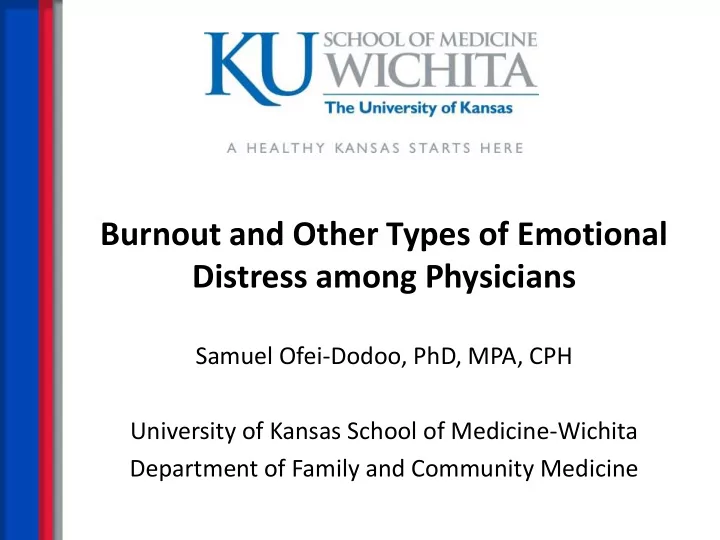

Burnout and Other Types of Emotional Distress among Physicians Samuel Ofei-Dodoo, PhD, MPA, CPH University of Kansas School of Medicine-Wichita Department of Family and Community Medicine
What is Job Burnout?
What is Job Burnout?
What is Job Burnout?
The Three Key Dimensions • Overwhelming exhaustion • Feelings of cynicism and detachment from the job • Sense of ineffectiveness and lack of accomplishment.
National Burnout Rates Burnout Rates: 2011-2017 60.0% 54.4% 45.5% 50.0% 43.9% Percentage 40.0% 28.6% 28.4% 28.1% 30.0% 20.0% 10.0% 0.0% 2011 2014 2017 US Physicians US Workers Shanafelt et al. 2019; in press.
Objective • Discuss the burnout rates among medical students, resident-physicians, and practicing physician in Sedgwick County
Methods • Used Abbreviated Maslach Burnout Inventory (MBI-9). • Three dimensions: – Emotional exhaustion – Depersonalization/cynicism – Perception of personal accomplishment
Methods: MSSC • 872 active member physicians of MSSC. • Email with link to survey. – 442 opened the email • 197 physicians responded
MSSC Results • Participation rate: 45% (197/442). • Response rate: 22% (197/872). • Study generally represented MSSC active member population.
MSSC Results Table 1. Demographic Characteristics of Responding Physicians Characteristics Responders (N = 197) Sex, No. (%) Male 106 (53.8) Female 77 (39.1) Missing 14 (7.1) Age, years Age group, No. (%) (n = 184) 25-34 8 (4.3) 35-44 54 (29.3) 45-54 46 (25.0) 55-64 54 (29.3) ≥65 22 (12.0) Years in Practice, No. (%) 1−9 37 (18.8) 10−19 59 (29.9) 20−29 44 (22.3) ≥30 41 (20.8) Missing 16 (8.1) Hours worked per week Range, No. (%) <40 17 (8.6) 40-49 38 (19.3) 50-59 59 (29.9) 60-69 39 (19.8) 70-79 13 (6.6) ≥80 17 (8.6) Missing 14 (7.1) Specialty, No. (%) Family medicine 48 (24.4) All other specialties 135 (68.5) Missing 14 (7.1)
MSSC Burnout Rates Personal Accomplishment 18.3 17.2 64.5 Low Depersonalization 54.8 18.3 26.9 Intermediate High Emotional Exhaustion 31.2 23.1 45.7 0% 10% 20% 30% 40% 50% 60% 70% 80% 90% 100%
MSSC Burnout Rates 49.5% of 197
MSSC Burnout Rates by Age Groups Age groups Burnout Rates 25-34 years 50% (4/8) 35-44 years 55.6% (30/54) 45-54 years 56.5% (26/46) 55-64 years 51.9% (28/54) 65 and over 13.6% (3/22)
KUSM-W Medical Resident Study • How do GME programs at KUSM-W burnout rates compared to the national data?
Methods Same methodology as MSSC study
Methods: KUSM-W • 280 resident-physicians. • Surveyed April to May 2017. • 131 residents completed the survey • Response rate: 47% (131/280).
KUSM-W Resident Burnout Rates 28.2 20.6 51.1 Personal Accomplishment Low 32.1 27.5 40.5 Depersonalization Intermediate High 33.6 29.8 36.6 Emotional Exhaustion 0% 20% 40% 60% 80% 100%
KUSM-W Resident Burnout Rates 51.1% of 131
MSSC vs. KUSM-W Burnout Rates Burnout Dimensions MSSC KUSM-W P-value Emotional Exhaustion 45.7% 36.6% 0.10 Depersonalization 26.9% 40.5% 0.011* Personal accomplishment 45.7% 51.1% 0.33
Burnout Rates: National vs MSSC vs KUSM-W 51.1 KUSM-W Residents 49.5 MSSC 43.9 National 40 42 44 46 48 50 52 Percentage
KUSM Medical Students Study • Determine how the rates of burnout among KUSM medical students compared to the previously published national data.
Methods Same methodology as MSSC and KUSM-W Studies
Methods: KUSM Medical Students • 872 KUSM medical students. • Surveyed July to September 2018. • Email with link to survey. – All students • A critical value of 0.05 two-tailed for all inferential statistics.
KUSM Medical Student Results • Overall response rate: 43.5% (379/872) – KC students: 40.5% (259/639) – ICT students: 48.8% (98/201) – Salina students: 28.1% (9/32) • Study sample generally represent the overall KUSM medical students’ population.
KUSM Medical Student Results by Campus Campus Location Burnout Rates Kansas City 48.3% (125/258) Wichita 50.0% (49/98) Salina 33.3% (3/9)
KUSM Medical Student Burnout Rates by year of training High Emotional Exhaustion High Depersonalization Burnout 70.0 60.0 50.0 Percentages 40.0 30.0 20.0 10.0 0.0 First Year Second Year Third Year Fourth Year
KUSM Medical Student Burnout Rates: All Years 60.0 50.0 40.0 Percentage 30.0 48.0 42.7 20.0 26.5 10.0 0.0 High Emotional Exhaustion High Depersonalization Burnout
Other Types of Emotional Distress Among MSSC Active Members
Other Findings of the MSSC Study (N = 197) Suicidal ideation 5 Loneliness 43 Excessive fatigue during the 44 past week Screened positive for 45 depression 0 10 20 30 40 50 Percentage
Why is this Topic of Burnout Important? • Depression : 2.43 (72.6% vs 30.4%; P < 0.01) • Fatigue : 1.89 (67.5% vs 35.8%; P < 0.01) • Loneliness : 2.19 (70.2% vs 49.5%; P < 0.01) • Suicidal Ideation : 2.13 (100% vs 46.9%, P < 0.01)
Why is this Topic of Burnout Important? • Patient care – Lower care quality – Medical errors – Longer recovery times – Lower patient satisfaction
Why is this Topic of Burnout Important? • Health Care System – Reduced physician productivity – Increased physician turnover – Less patient access – Increased costs (4.6 billion) 3
Causes of Burnout 4 • Work-life imbalance • System issues • Difficult patient population • Unrealistic expectations
Wellness Promotion 3 • Administrative, program & system changes • Enhanced leadership & faculty/resident relations • Promotion of healthy/mindfulness activities
References 1. Shanafelt et al. Changes in burnout and satisfaction with work-life integration in physicians and the general US working population between 2011 and 2017. 2. Maslach C & Leiter MP. New insights into burnout and health care: Strategies for improving civility and alleviating burnout, Med Teach. 2017;39(2):160-163. 3. Han S et al. Estimating the Attributable Cost of Physician Burnout in the United States. Ann Intern Med. 2019;170(11):784-790. 4. Ofei-Dodoo, S, Callaway P, Engels K. Prevalence and etiology of burnout in a community-based graduate medical education system: A mixed method study. Family Medicine 2019; in press.
THANK YOU
Recommend
More recommend